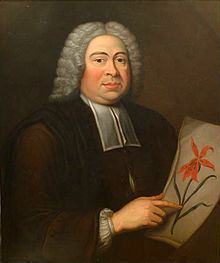Nationality German Alma mater University of Giessen Role Botanist Fields Botany | Institutions Oxford University Name Johann Dillenius Education University of Giessen | |
 | ||
Died April 2, 1747, Oxford, United Kingdom | ||
Johann Jacob Dillen Dillenius (1684–2 April 1747) was a German botanist.
Dillen was born at Darmstadt and was educated at the University of Giessen, where he wrote several botanical papers for the Ephemerides naturae curiosorum, and printed, in 1719, his Catalogus plantarum sponte circa Gissam nascentium, illustrated with figures drawn and engraved by his own hand, and containing descriptions of many new species. In 1721, at the instance of the botanist William Sherard (1659—1728), he moved to England, and in 1724 he published a new edition of John Ray's Synopsis Methodica Stirpium Britannicarum. In 1732 he published Hortus Elthamensis, a catalogue of the rare plants growing at Eltham, London, in the collection of Sherard's younger brother, James (1666—1738), who, after making a fortune as an apothecary, devoted himself to gardening and music. For this work Dillen himself executed 324 plates, and it was described by Linnaeus, who spent a month with him at Oxford in 1736, and afterwards dedicated his Critica botanica to him, as opus botanicum quo absolutius mundus non vidit. Linnaeus would later name a genus of tropical tree Dillenia in his honor. In 1734 Dillenius was appointed Sherardian professor of botany at Oxford, in accordance with the will of W. Sherard, who at his death in 1728 left the university 3000 pounds for the endowment of the chair, as well as his library and herbarium, all on the condition that Dillenius should be appointed the first professor.
Dillen, who was also the author of an Historia muscorum (1741), died at Oxford, of apoplexy. His manuscripts, books and collections of dried plants, with many drawings, were bought by his successor at Oxford, Dr. Humphry Sibthorp (1713–1797), and ultimately passed into the possession of Oxford University. For an account of his collections preserved at Oxford, see The Dillenian Herbaria, by G. Claridge Druce (Oxford, 1907).
The standard author abbreviation Dill. is applied to species he described.
